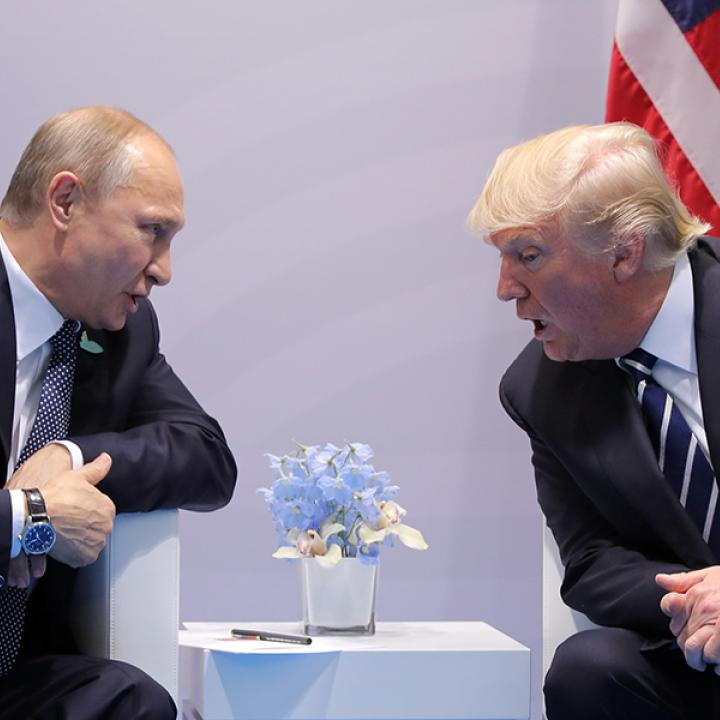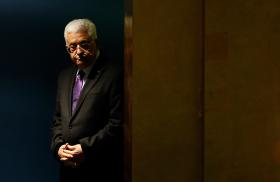
- Policy Analysis
- PolicyWatch 2825
The Trump-Putin Sideline and the Syria Conflict

Whatever the two leaders discuss at the G20 summit, the Trump administration must work urgently to develop a new Syria strategy that articulates a clear vision for the country's future and the U.S. readiness to protect it.
On July 7, U.S. president Donald Trump and Russian president Vladimir Putin will meet on the sidelines of the G20 summit. Among the topics certain to come up is the Syria conflict, an area on which the two leaders will struggle to find common ground.
Al-Shayrat Strike and Aftermath
With regard to Syria, the April U.S. airstrike on the regime-controlled al-Shayrat Air Base was an important move in that it signaled to Moscow that Trump will be more decisive in his use of force than was his predecessor, Barack Obama. The airstrike also showed Syrian president Bashar al-Assad that Russian support does not guarantee absolute protection should Damascus continue engaging in moves viewed as intolerable by the international community, such as the use of chemical weapons (CW), whether against the opposition or the Syrian population.
The al-Shayrat strike, however, was not a game changer. This is because neither the Syrian regime nor its Russian and Iranian allies have altered their strategy in its wake. Russia, in particular, has maintained a strategy rooted in applying military and political pressure on the opposition, with the goal of persuading anti-Assad forces and their foreign sponsors to adopt a Russian vision of post-conflict Syria. According to this vision, the Assad regime will survive, thereby ensuring Russia's active presence in the country's political and economic life after the fighting ends.
The key reason for Russian maintenance of the status quo was the lack of U.S. follow-up. In the days after the strike, Moscow was preparing for potential changes in the U.S. approach to Syria, including increased U.S. military pressure on Damascus and a severing of any hopes of dialogue between the West and Russia on Assad. Yet no such changes occurred. U.S. secretary of state Rex Tillerson honored his plans to visit Moscow, even as his British counterpart, Boris Johnson, canceled his. Russian worries, in turn, were allayed, with the Kremlin deducing that while Trump might be prepared to use force, he -- like Obama -- wanted to avoid getting too deeply mired in Syria. Russia could thus continue to view itself as the main player in the country.
Moreover, when Trump recently threatened a repeat military action against Assad over prospective CW use, Russia likely felt confident that its influential role in the conflict would endure. Such confidence emanates from a sense of its stronger overall position, as compared to the West, in the war. Thus, whereas the recent downing of a Syrian jet by coalition forces placed the Russians on alert, the Kremlin remained generally unbothered by intensified U.S. actions in May and June. Further, Russian officials believe that Trump's decisionmaking process on Syria remains hectic and that the U.S. administration has yet to settle on a long-term strategy. Given this bigger picture, Putin is unlikely to be shaken by the occasional U.S. statement threatening strikes over CW use. One possible explanation for the latest threat, in Moscow's view, was to show Trump's military machismo, versus Obama's perceived weakness, before the G20 encounter with Putin. The Russians have thus remained silent on this issue, preferring to wait for the actual meeting before signaling a next step in the U.S.-Russia dialogue on Syria.
De-Escalation Zones
A central move now being initiated by Russia to strengthen its negotiating position is the establishment of de-escalation zones, a purely tactical gesture to buy time for the Syrian regime and its supporters. From the Russian point of view, these zones are meant to pursue several particular goals:
- Russia shows, in introducing this idea, that it remains the leader in negotiations over a Syrian political settlement. Furthermore, in compelling other international players to focus on this and other Russian initiatives, the Kremlin diverts these countries' attention from their own strategies.
- Russia was concerned about rumors that the Trump administration would introduce its own no-fly zones, which would fragment Syria into sections purportedly favorable to the opposition. Russia therefore hurried to introduce an alternative that would create Sunni enclaves -- instead of splitting up the country -- and establish de-escalation zones under the control of Damascus's allies.
- De-escalation zones will regionalize the Syrian conflict and isolate the most hostile military groupings within those areas of deconfliction. Russia also expects that the pro-Turkey groupings and Hayat Tahrir al-Sham (HTS; formerly Jabhat al-Nusra and Jabhat Fatah al-Sham) forces stuck within the de-escalation zones will fail to find common cause and start fighting each other. On this front, Damascus reportedly released several hundred Ahrar al-Sham fighters from prison in April and transferred them to Idlib to strengthen their position against HTS. Related has been the recent omission of HTS from Russia's antiterrorism rhetoric, which has switched its focus to the Islamic State (IS). Some experts suggest this shift was intentional, aimed at unofficially acknowledging HTS as a controlling force in the deconfliction zones and thus setting it up for inevitable clashes with other groupings.
- Generally, the creation of four relatively functioning zones will keep the Syrian opposition busy struggling for power inside them. Meanwhile, Moscow will be able to concentrate on the struggle against IS. If the deconfliction zones strategy is implemented successfully, Russia will launch a full-scale offensive on Deir al-Zour, whose fall will be cast by Moscow as a victory over IS and a formal achievement of Russian goals in Syria. Russian propaganda will portray Moscow as the clear winner, as contrasted with the "slow progress" registered by the West in fighting IS in Iraq. Russia may also use this feat as a pretext for partially disengaging from the Syrian morass.
Finally, Moscow views the proposed de-escalation zones as an outgrowth of its past experience in establishing local ceasefire agreements between Damascus and local fighting groups. Indeed, these successes contrast starkly with the failure of global political talks in Geneva and Astana, providing encouragement for Russia to press forward.
Conclusions
Given the Russian approach just outlined, the Trump administration must work urgently to develop a new Syria strategy that articulates a clear vision for the country's future and the U.S. readiness to protect it. Only then will real, effective U.S.-Russia discussions become possible. The absence of such a U.S. strategy, by contrast, will show Russia that the United States is not prepared to be a serious player in Syria. And should U.S.-Russia dialogue on Syria stagnate, Moscow could make dangerous adjustments to its policy, moving further still from the U.S. position.
The brief background here is that after Trump's victory in the U.S. presidential election, the Kremlin expected the beginning of a sustainable dialogue on prospects for conflict settlement in Syria, the anti-IS struggle, and the country's post-conflict future. Even as Moscow harbored no illusions about the challenging nature of these talks -- and planned to convince Washington of the justness of its own vision -- a mere start to dialogue on concrete issues would have been perceived by Russia as progress. But such a beginning required that the Russian leadership see a new U.S. agenda in Syria clearly set forth by the White House. That, in Moscow's opinion, has not yet happened.
In the continued absence of a clear U.S. policy on Syria, Moscow may become less and less interested in further dialogue with Washington. Such an outcome would see Russian authorities keeping only minimal contacts with their U.S. counterparts instead of trying to boost them. Meanwhile, to ensure implementation of their de-escalation zones, Russian officials will concentrate their attention on dialogue with regional players, namely Turkey and Iran. The U.S. ability to influence Russian approaches to Syria will thereby be further diminished.
Such a greater Russian focus on cooperation with regional powers, at the expense of deep dialogue with the United States, will likewise serve the interests of Tehran, making the Kremlin even more dependent on Iranian proxies to implement the de-escalation zones. Needless to say, Iran has already gained much from Russian intervention in Syria in terms of its influence in Syria and the Levant. Although the divergent long-term goals of Russia and Iran in Syria undoubtedly concern Moscow, stalled talks with the West will -- at least for the short term -- compel the Kremlin to rely on Tehran and its minions to achieve its goals.
Nikolay Kozhanov, a former visiting fellow with The Washington Institute, is an Academy Associate at Chatham House.



